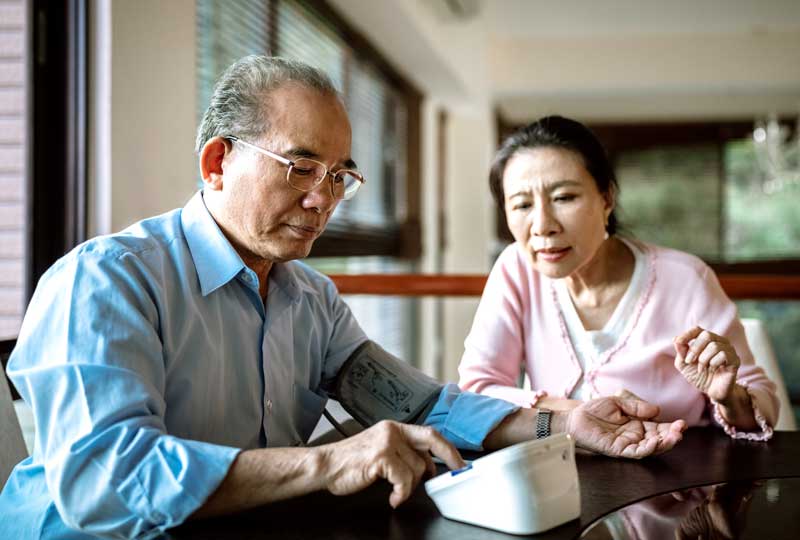If you’re at risk for an abdominal aortic aneurysm, these lifestyle modifications can help you avoid a life-threatening rupture.
There are still many unknowns about abdominal aortic aneurysms, which occur when the wall of the aorta — the body’s largest blood vessel — begins to bulge and weaken.
“We do know that once they form, over time they eventually grow and rupture,” said Stacey Becker, RN, a physician liaison at Vanderbilt Heart and Vascular Institute. “And we know that there are risk factors that cause formation first, and then if those risk factors aren’t taken care of, they will cause the abdominal aortic aneurysm to grow — and ultimately rupture — faster.” Those factors that lead to formation are smoking and a family history of abdominal aortic aneurysms — smoking being the dominant risk.
For many living with an abdominal aortic aneurysms, surgery is an option, either an open repair procedure or a less-invasive endovascular aneurysm repair (EVAR). Other patients, however, may not be good surgical candidates due to other underlying conditions.
“We know that there are risk factors that cause formation first, and then if those risk factors aren’t taken care of, they will cause the abdominal aortic aneurysm to grow — and ultimately rupture — faster.”
“Another thing we do know about abdominal aortic aneurysms is that rupture leads to death,” Becker explained. “Therefore, we have a lot of philosophical conversations with patients about whether they want to pursue treatment. For patients who are poor surgery candidates and ultimately decide not to seek a procedure, the best treatment is to modify their risk factors.”
The good news is that the following lifestyle modifications can improve patients’ outcomes. Take these steps to manage your abdominal aortic aneurysm risk factors.
1. Stop smoking.
Even a remote history of smoking — for example, you smoked a pack a day for a year a decade ago — can put you at risk. The damage done to the blood vessels from any amount of smoking in a patient’s history can cause damage that will lead to aneurysm formation.
If you’re still smoking, it’s essential to quit.
“That’s the very first thing we instruct our patients to do,” Becker said, “because it’s the most crucial.” There’s not a one-size-fits-all method Becker and her team recommend — some patients have success with support groups or medications; others have found hypnosis effective. “They just need to stop smoking,” Becker said — the sooner, the better.
2. Manage hypertension and cholesterol with the help of a primary care physician.
“The next thing we recommend is getting into some quality care with a good primary care physician,” Becker said. The main things to ask your physician to track? Hypertension and cholesterol.
“If a patient is able to control their blood pressure once an abdominal aortic aneurysm has formed,” Becker said, “there’s some literature out there that suggests that it will not grow at such a fast rate.” Your physician may recommend medication as well as a change to your diet to keep both your blood pressure and cholesterol levels low enough to slow the growth of your abdominal aortic aneurysm.”
3. Seek out your potential vascular surgeon.
Your primary care physician can assess your risk factor and the need for testing. Once a diagnosis has been made, it’s time to locate and meet a board-certified vascular surgeon. Getting a plan for follow-up, as well as a detailed understanding of what is involved with a potential repair of your unique abdominal aortic aneurysm, is best done at the outset.
4. Follow your surveillance plan.
Once you’ve been diagnosed, your providers will need to know A) its baseline and B) its rate of growth. In order to closely monitor your aneurysm, you’ll likely undergo the following tests:
- Computed tomography angiography (CTA). This test, which combines a CT scan with the injection of a special dye to illuminate blood vessels and arteries, will provide an initial understanding of your abdominal aortic aneurysm’s baseline. “It gives us a good roadmap of the anatomy,” Becker said, and allows the team to have a full understanding of your abdominal aortic aneurysm.
- Ultrasound. Once a CTA is on file, ultrasounds will be used on a 6-month or annual cycle (depending on the size of your abdominal aortic aneurysm and your other comorbidities) to monitor your aneurysm’s growth.
5. Stay active and maintain a healthy weight.
“Sometimes patients get scared, thinking they cannot lift anything heavy,” Becker said. “There has not been anything that suggests that they cease activity level. In fact, there’s nothing that patients with abdominal aortic aneurysms can physically do to cause the aneurysm to rupture.” Becker recommends continuing your normal activities and even increasing that activity, slowly and steadily. Maintaining a healthy weight is not only important for mitigating rupture risks but can also help you recover after surgery, should you need an intervention.
6. Ask your family members to get a screening done.
Since family history is the other big risk factor, it’s important to understand whether or not there have been aneurysms in your family. For those who’ve had a diagnosis, Becker advises them to encourage their siblings and children to get a screening.

If you are seeking expert care for a heart condition, the dedicated specialists at Vanderbilt Heart and Vascular Institute can provide you with the personalized treatment you need. Our team works together to give you the best possible care, so you can continue to live an active, healthy life. Our multiple locations mean that you are always close to advanced heart care. For an appointment, call 615-322-2318.

